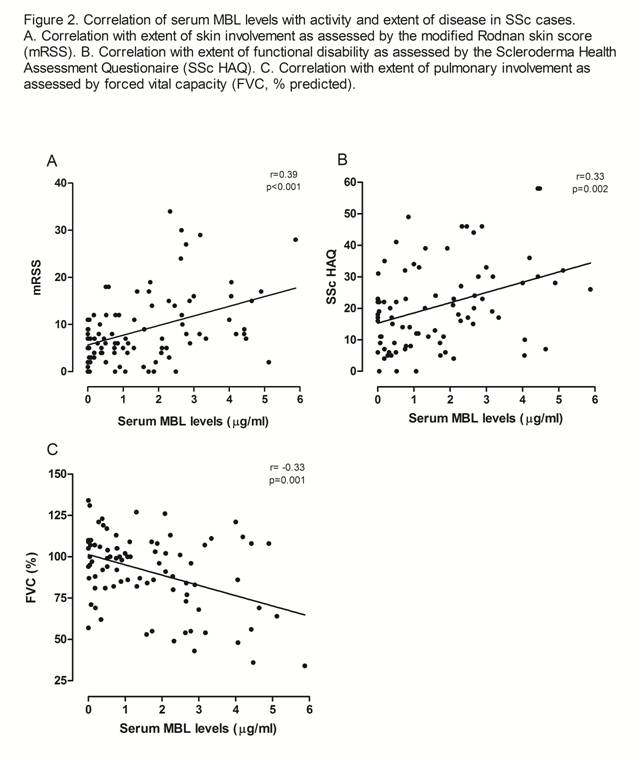Session Information
Title: Systemic Sclerosis, Fibrosing Syndromes and Raynaud's - Pathogenesis, Animal Models and Genetics
Session Type: Abstract Submissions (ACR)
Background/Purpose:
Repetitive episodes of ischemia and reperfusion (I/R) are a cardinal feature of the pathogenesis of systemic sclerosis (SSc), which precedes tissue fibrosis. The complement system is a key mediator of tissue damage after I/R, primarily by activation of the lectin pathway. This study investigated whether serum levels and polymorphisms of mannose-binding lectin (MBL) and ficolin-2 (FCN2), two pattern recognition receptors of the lectin pathway, are associated with the predisposition to, and clinical features of SSc.
Methods:
A case-control study was undertaken involving 90 patients with SSc according to the American College of Rheumatology (73/90) or the LeRoy and Medsger criteria (17/90) from a single SSc outpatient clinic and 90 age- and sex-matched blood donors. MBL and FCN2 levels and polymorphisms were measured in both groups, and in cases correlated with clinical data.
Results:
MBL levels and genotypes were equally distributed in cases and controls while there were some significant differences in FCN2 polymorphisms. Median MBL levels were higher in SSc cases with diffuse disease compared to controls (2.6 vs. 1.0 µg/ml, p<0.001).
In cases, higher MBL levels were associated with the presence of clinical findings associated with vascular dysfunction and local tissue damage (digital ulcers, calcinosis and pitting). Moreover, MBL levels were associated with fibrotic disease manifestations as evidenced by the presence of diffuse disease (median 2.6 vs. 0.8 µg/ml, p=0.002), the modified Rodnan skin score (r=0.39, p<0.001), and interstitial lung disease as measured by forced vital capacity (r=-0.33, p=0.001). Importantly, MBL levels also correlated with the SSc Health Assessment Questionnaire scores (r=0.33, p=0.002). Results for FCN2 levels were less striking. Phenotypic MBL results were largely confirmed by analysis of MBL polymorphisms. MBL levels were not associated with the presence of autoantibodies or hypocomplementemia.
Conclusion:
Overall, predisposition to SSc was not influenced by the lectin pathway of complement in our matched case-control study. However, our preliminary data suggest that MBL, and to a lesser extent FCN2 may modulate disease manifestations of SSc, particularly in diffuse cutaneous disease.
Acknowledgments:
Kathleen Elford, Scleroderma Nurse for her assistance in collection of data and samples. SSc patients were recruited from Monash Health as part of the Australian Scleroderma Cohort Study (ASCS), a longitudinal, prospective study of SSc patients.
Disclosure:
M. Osthoff,
None;
G. S. Ngian,
None;
M. Dean,
None;
M. Nikpour,
None;
W. Stevens,
None;
S. Proudman,
None;
D. Eisen,
None;
J. Sahhar,
None.
« Back to 2014 ACR/ARHP Annual Meeting
ACR Meeting Abstracts - https://acrabstracts.org/abstract/the-lectin-pathway-of-complement-a-potential-role-in-the-pathogenesis-and-disease-manifestations-of-systemic-sclerosis/


